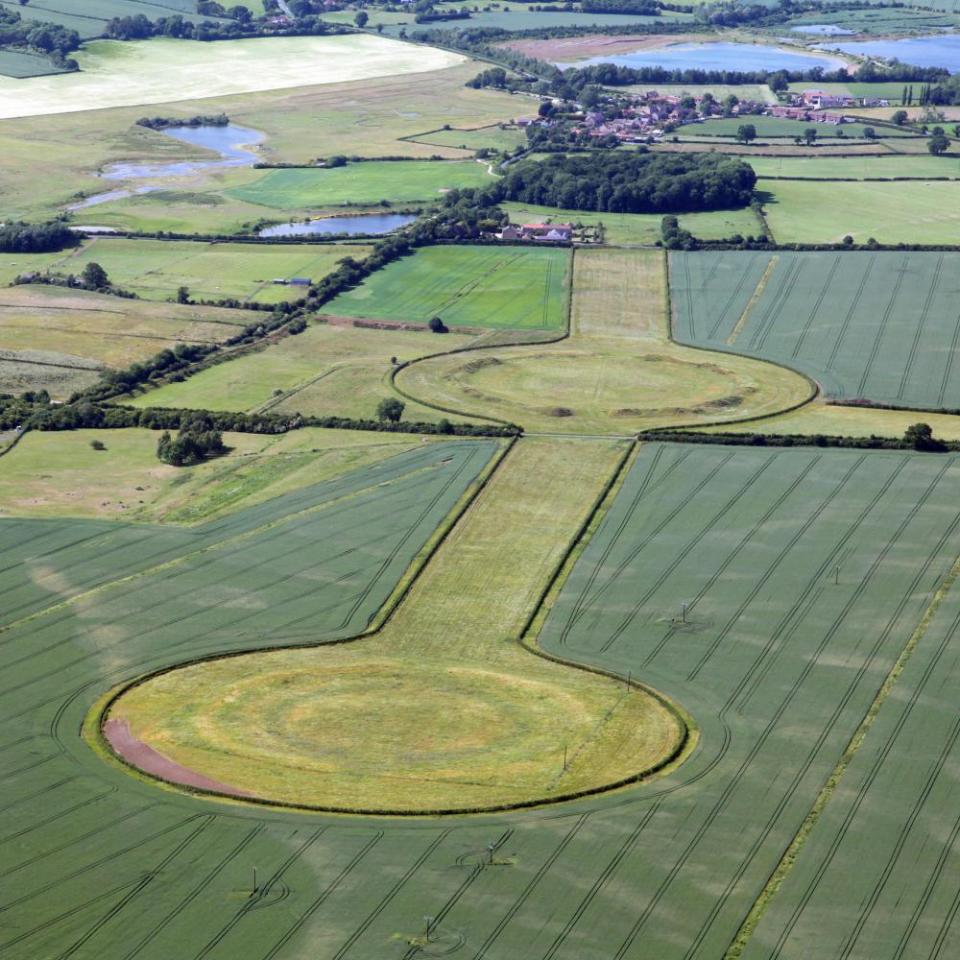Forgotten ‘Stonehenge of the north’ given to nation by construction firm
Two enormous and thrillingly mysterious ancient monuments, part of a complex regarded as the Stonehenge of the north, have been given to the nation and will come off England’s heritage at-risk register.
The Thornborough Henges, near Ripon, in North Yorkshire, are three huge, human-made, enclosed earth circles. Each is more than 200 metres in diameter and they date from 3500BC to 2500BC, making them late neolithic/early bronze age monuments.
Precisely why the circles were created is a matter of debate. What is agreed is that they are a true wonder of the north, part of one of the UK’s most important ancient sites.
Historic England and English Heritage announced, after years of concern, they had secured the future of two of the henges and parts of the surrounding landscape.
English Heritage will manage the site and said it was welcoming visitors to the henges which, despite their importance, are not widely known, from Friday.
Joe Savage, a senior interpretation manager at English Heritage, agreed they were not well known – “at the moment”. He said: “I live in Yorkshire and have a good understanding of the landscape and the area but when I started looking at the site a few years ago, it came as a surprise to me.
“It is an incredible series of monuments. They’re awe-inspiring … so it is fantastic that they’re now in national care.”
The circular earthworks are thought to be part of a “ritual landscape”, comparable to Salisbury Plain, home to Stonehenge.
There are three henges running north to south over a mile long. Two have been given to the nation by the construction company Tarmac. Lightwater Holdings, a local company, has given parts of the wider monument.
Those two Thornborough Henges were added to Historic England’s heritage at-risk register in 2009 because of erosion caused by livestock and rabbits. The new deal, which makes Historic England the legal owner, will lead to the two henges, the central and southern ones, being taken off the register.
The human effort to make the henges would have been enormous, comparable to Stonehenge or the standing stones at Avebury. The earth banks around the circles would have been around 5 metres high and there is evidence they would have been coated with bright white gypsum.
“They would have been quite visible monuments and epic,” said Savage. “Who knows how they were used, but if you’re standing in the middle of them and you looked around, all you would have been able to see is the sky and this incredible vast wall of white surrounding you.”
There is a magic about the henges even today when the experience is more pastoral, said Savage. “When you walk between them you are walking in the footsteps of people 5,000 years ago. You’re taking the same route, experiencing the same skies. There is something that grounds you in deep history when you’re in the spaces.”

The henges, close to the A1, are in the Richmond constituency of the prime minister, Rishi Sunak. He welcomed the announcement and the potential for the site to help tell the story of ancient Britain.
“Comparatively few people are aware of its significance – both locally and nationally. I hope many more will come to appreciate this little-known gem of our history and while doing so provide a welcome boost to the local visitor economy.”
The deal means the two henges become part of the National Heritage Collection, joining places such as Stonehenge, Iron Bridge, Dover Castle and numerous forts on Hadrian’s Wall. The third henge is privately owned and not on the at-risk register.
Duncan Wilson, chief executive of Historic England, said the henges and their surrounding landscape “form part of the most important concentration of Neolithic monuments in the north of England. They are a link to our ancient ancestors, through thousands of years, inspiring a sense of wonder and mystery. We are thrilled.”
Kate Mavor, the chief executive of English Heritage, echoed his sentiments: “Thornborough Henges is one of the most important ancient sites in Britain and yet almost completely unknown. We are looking forward to sharing its significance, its stories and its secrets with the public.”

 Yahoo Movies
Yahoo Movies 
